Jump Back and Forward: Smooth Yoga Transitions
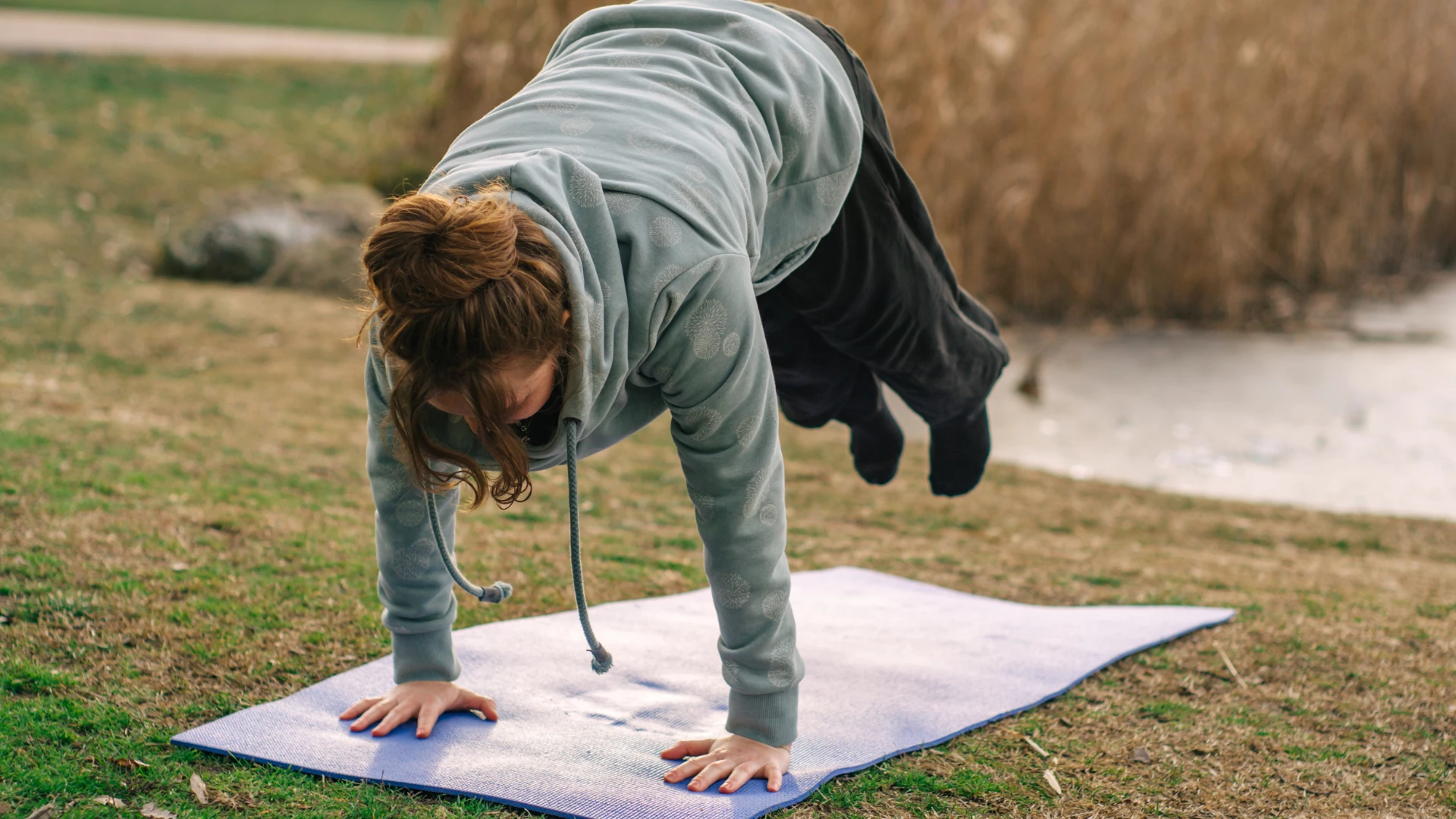
Article At A Glance
Do you practice jump backs and jump forwards in your Vinyasa yoga practice? These challenging transitions can certainly be exhilarating. Yet, if practiced repeatedly in a not anatomically informed way, they can also lead to overuse issues. On the flip side of that, executed mindfully and skillfully, jump backs and jump forwards can be smooth and safe Vinyasa yoga transitions.
Further, working toward proper alignment and kinetic integration in these transitions can enhance physical and mental strength; we can refine physical actions and the ability of our mind to focus inwards. Short of that, smoothly accomplishing such actions can feel empowering and just plain fun! Let’s look closer at how to get there.
Jump Backs and Jump Forwards Are Not for Everyone
Before going further, let’s be clear: jump backs and forwards might not be wise, or even accessible, for all bodies. That’s an example of how yoga is for everybody (and every body), but not all yoga is for everybody.
In some cases, it might take time to build the strength and physical integration to jump back and forward. Baby steps toward the former include Three-Legged Plank (Eka Pada Phalakasana) (shown below), Standing Split (Urdhva Prasarita Eka Padasana), and Four-Limbed Staff Pose (Chaturanga Dandasana) variations. One can practice “Donkey Kicks” and Crow Pose (Bakasana) variations toward jump forwards.
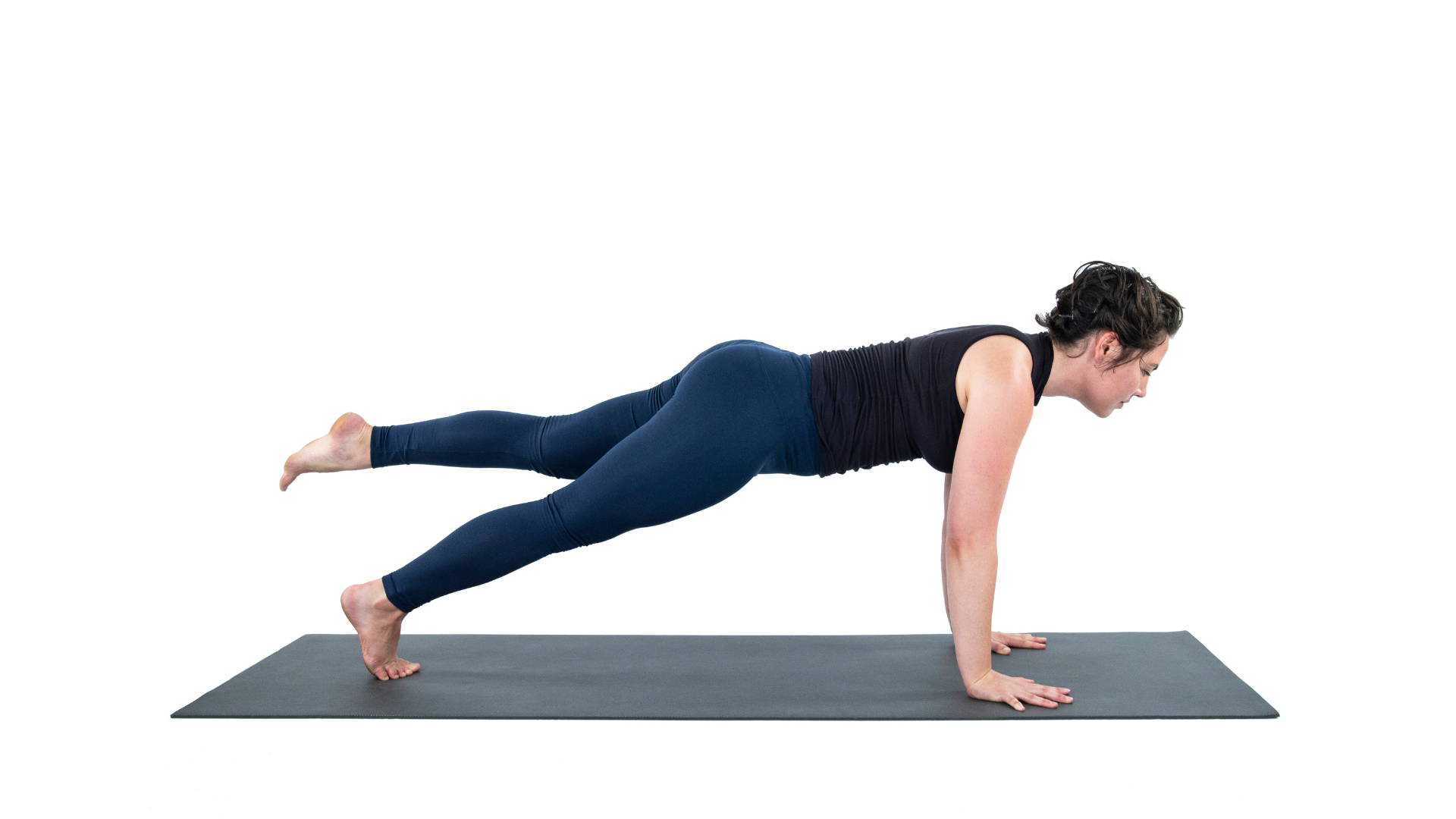 Cases of the shoulder, wrist, ankle, knee, or spinal/neck injury might call for sufficient time for the body to heal before working on these formidable Sun Salutation (Surya Namaskar) transitions or even on the baby steps toward them. Alternatively, as we ease back into more physically challenging practice, such baby steps could be stepping stones to these yoga movements once our bodies are ready for them.
Cases of the shoulder, wrist, ankle, knee, or spinal/neck injury might call for sufficient time for the body to heal before working on these formidable Sun Salutation (Surya Namaskar) transitions or even on the baby steps toward them. Alternatively, as we ease back into more physically challenging practice, such baby steps could be stepping stones to these yoga movements once our bodies are ready for them.
In other cases, alternatives to these Vinyasa yoga transitions are simply wiser for the longer term or even permanently, and that’s just how it is. There’s absolutely nothing wrong with alternate transitions, such as simply stepping forward or backward to the next pose in a sequence and keeping those alternates for the long haul. In fact, that could very much be the better choice for you.
You Don’t Always Have to Practice Jumping Vinyasa Yoga Transitions
Moreover, just because one can practice these Vinyasa yoga transitions doesn’t mean that they always (or ever) should practice them. Here’s an illustrative personal example. Earlier in my practice journey, I jumped back in every Vinyasa sequence, and I was in class pretty much daily. I also started experiencing persistent, low-grade backache around this time—in my late 20s, mind you).
I asked an instructor about potential causes connected with my practice, and she pointed to constant jump backs as one possibility. I reduced these jump backs to once per class and made a couple of other adjustments in my practice. My back pain began to fade. Of course, that’s anecdotal rather than scientific, but I think it points to something significant.
There might be other times when your body is not in the optimal state to practice these challenging Vinyasa yoga transitions, whether from injury, soreness, or simply fatigue. Those are not messages to breezily brush aside. As master teacher Jason Crandell has quipped, “Better to injure your ego than your body.”
Indeed, in such cases, much of the yoga would be practicing Aparigraha (non-attachment) enough to accept alternatives to jump backs as plenty of challenges. We can also practice Santosha (contentment) enough to experience satisfaction and easeful joy within that adjusted level of challenge. I’m certainly still working on all that, but I’m on the path. That, dare I say, is the important thing.
Vinyasa Yoga Transition Tips: Just Go For It!
 If practicing jump backs does seem to be a wise answer for you during any given practice, follow these steps to set yourself up for smooth Vinyasa yoga transitions:
If practicing jump backs does seem to be a wise answer for you during any given practice, follow these steps to set yourself up for smooth Vinyasa yoga transitions:
- From Standing Forward Bend Pose (Uttanasana), line your fingertips up with your toes, hands on either side of your feet, to draw a roughly even line across your fingers and toes. Bend your knees as generously as you need to to get your palms firmly down on your mat.
- Now’s as good a time as any to establish important actions for Chaturanga Dandasana so that you have them when you jump back to that position. Find Yoga Hand Lock (Hasta Bandha) by pushing through every fingertip and every knuckle. Spin your biceps forward and your triceps back. Lift your kneecaps and guide your inner thighs back. Remember that within Vinyasa yoga practice, how we set up each pose impacts our experience and safety within the poses to come next.
- When you’re ready to jump back, bend your knees even more. Line up your gaze (Drishti) so that both the front and back of your neck are long. Look on a diagonal, both out and down, rather than fully down or fully out.
- As you breathe out, just go for it. Jump back to Chaturanga! You got this! It’s one of those things not to overthink, especially if you feel fear sowing doubt in your mind (fear unsupported by the facts of the situation, that is). The only way to do it is to do it. (That said, it can be helpful to shoot your legs straight back, without jumping them upward, as much as possible. This helps to keep you from coming down hard on your toes.
- To not collapse through your body when you get to Chaturanga, feel your hips and your hyoid bone area (at the upper throat) lift.
- Continue moving through poses from Chaturanga in the way that an instructor guides you, as well as how your body, mind, and spirit are guiding you.
Jump Back Safety: Safe Vinyasa Yoga Transitions
 It is common in Chaturanga for teachers to instruct students to place their elbows at a 90-degree angle. Ninety degrees is where your elbows line up over your wrists, and your elbows are pointing straight back from your shoulders. For many practitioners, this cue can help prevent shoulder injuries.
It is common in Chaturanga for teachers to instruct students to place their elbows at a 90-degree angle. Ninety degrees is where your elbows line up over your wrists, and your elbows are pointing straight back from your shoulders. For many practitioners, this cue can help prevent shoulder injuries.
However, if your humerus (upper arm) bones are especially long, this alignment may not work. For example, if your elbows align with your pelvic rim when you stand in Tadasana, bending 90 degrees will place your hands and wrists at pelvis level. If you try to bend your elbows to 90 degrees, your upper body will not be properly supported in Chaturanga. For those with long humerus bones, this alignment can also cause undue strain on the wrists and hands.
Prop Use Tip #1: If you’re not sure how much to bend your elbows before you set up to jump back, (step 1) set up blocks at the highest height at shoulder-width apart. Set up your fingers and toes behind the blocks, and proceed through the abovementioned steps.
When you jump back, bend your elbows enough so that the fronts of your shoulders tap the blocks. It could be useful to practice lowering from Plank Pose (Phalakasana) to tapping your shoulders to the blocks in Chaturanga before doing so with the jump back.
Additionally, when in Chaturanga be sure to draw your ankles slightly inward to avoid them splaying out. This can cause overstretching in the area and, thus, instability there over time. Among injuries in Vinyasa yoga practitioners, ankle sprains are common. Lower body injuries overall are common, more so than in the upper body. (1)
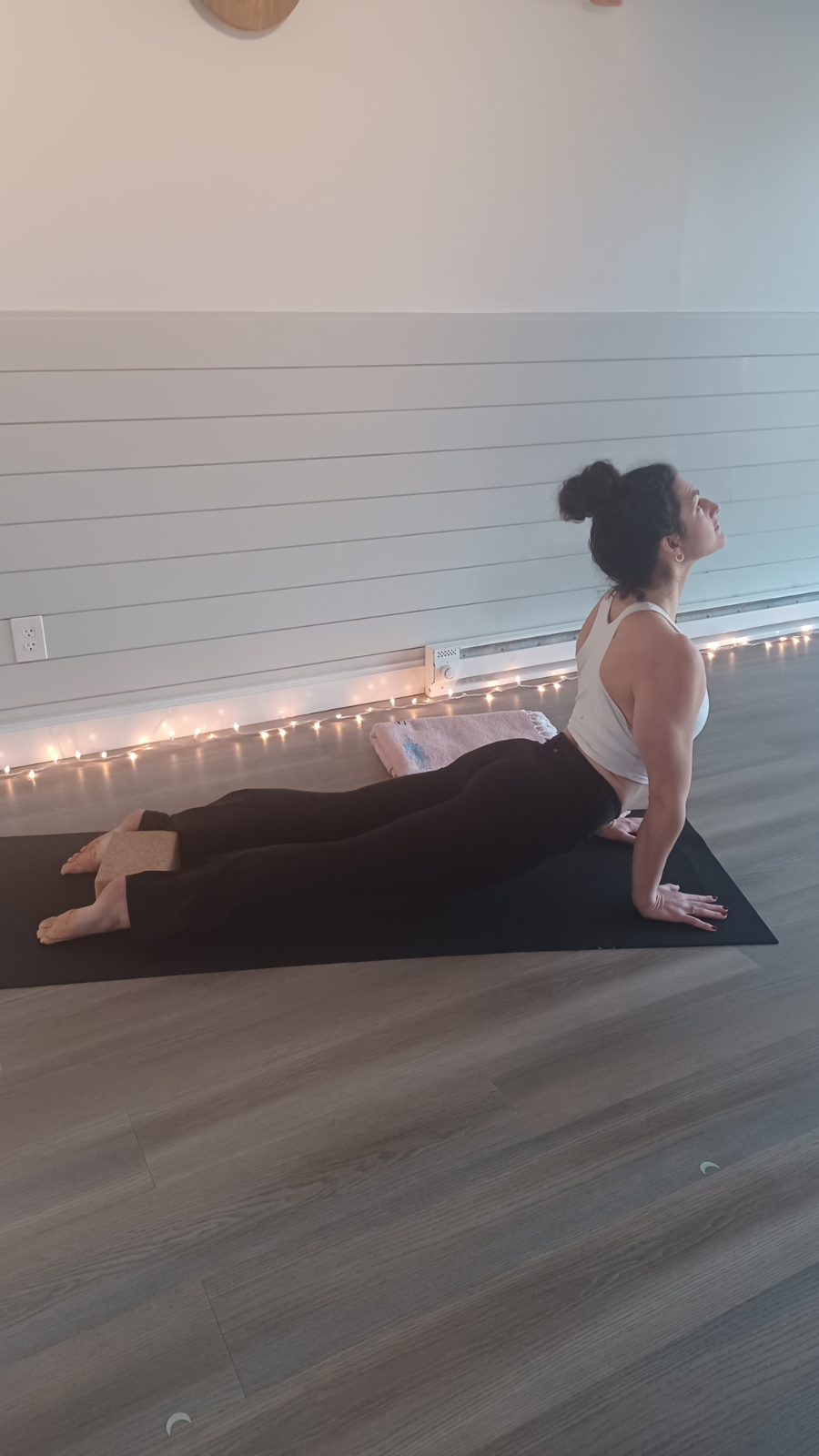 Prop Use Tip #2: To feel the action of hugging your ankles gently inward, try practicing Plank Pose with a block in between your ankles, the block at the widest width. Try lowering to Chaturanga from there, maybe even flipping your feet to Upward Facing Dog Pose (Urdhva Mukha Svanasana)! None of that is easy by any means, but it could be a fun challenge, and it will truly teach you to draw your ankles inward.
Prop Use Tip #2: To feel the action of hugging your ankles gently inward, try practicing Plank Pose with a block in between your ankles, the block at the widest width. Try lowering to Chaturanga from there, maybe even flipping your feet to Upward Facing Dog Pose (Urdhva Mukha Svanasana)! None of that is easy by any means, but it could be a fun challenge, and it will truly teach you to draw your ankles inward.
How in the world do you get the block in between your feet and then take Plank Pose, you might wonder? An instructor or a yoga friend could place it there for you while you’re already in Plank Pose. If you’re practicing alone, you can kneel at the back of your mat, reach back behind you and down to place the block in between your ankles, and then walk out to Plank Pose once it’s secured there.
Jump Forward Tips: Smooth, Safe Vinyasa Yoga Transitions
On the other end of a Surya Namaskar, or a variation thereof, is the jump forward! If this transition feels right for you today, get ready to fly with these actions:
- Step your feet together from Downward Facing Dog Pose (Adho Mukha Svanasana).
- Bend your knees a lot, and then lift your hips toward the sky. If you’ve done “Donkey Kicks,” it’s the same setup.
- The Drishti is key here. Look in between your hands. That’s where you want to go!
- As you breathe out, clear and strong, jump! As with jump backs, the only way to do it is to do it. If fear not supported by the facts is coming up for you, simply notice it and then let it pass. Then go for it!
- If you can’t get all the way in between your hands, back to Uttanasana, simply step the rest of the way forward.
- Continue with your Sun Salutation yoga flow to wherever you’re headed next. This could also be something more restful, of course!
Practice is Essential
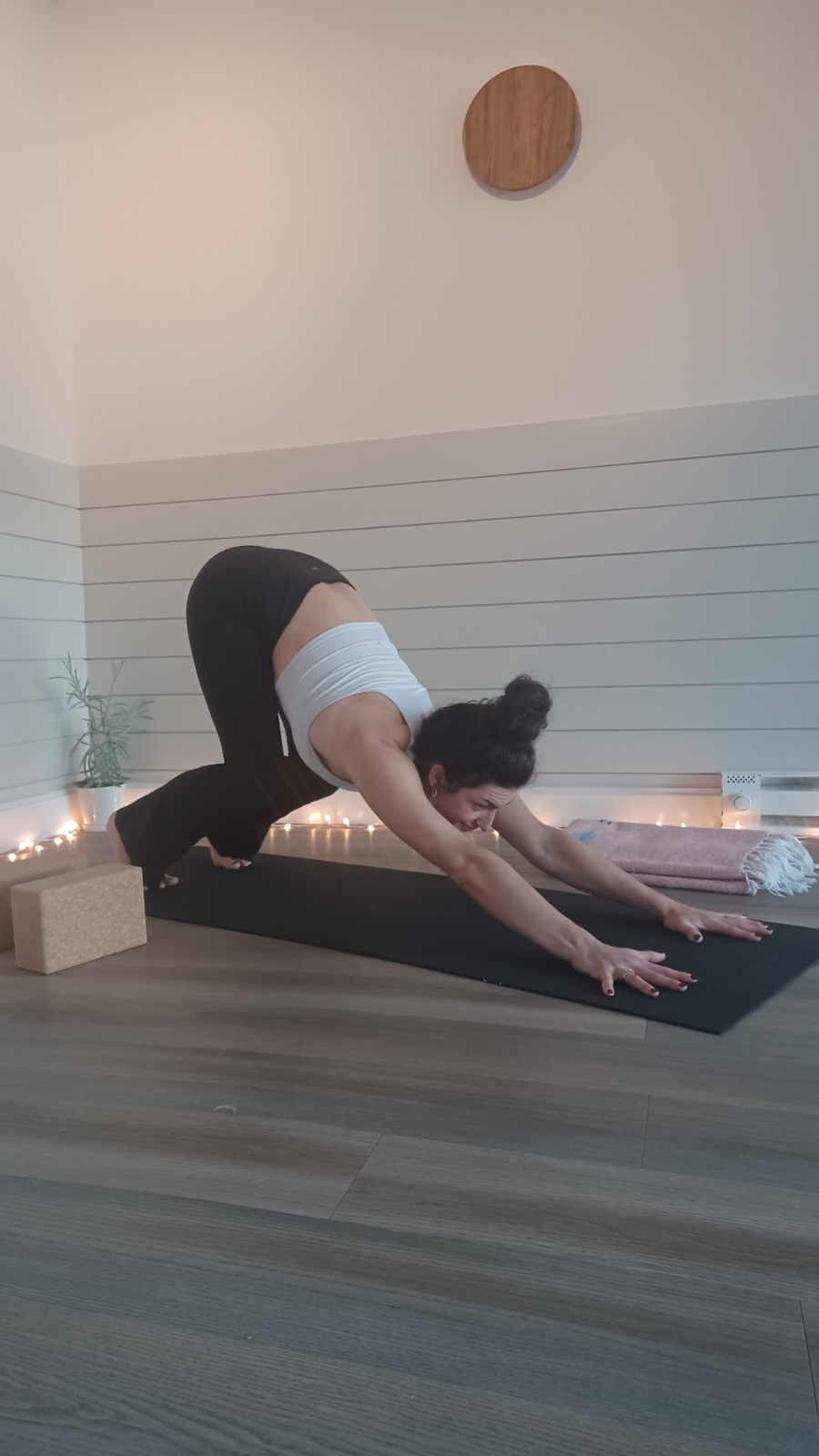 For Vinyasa yoga transitions, the phrase “it’s a practice, not a perfect” might feel cliché, but that’s because it’s true. You have to come to your mat many times and work on them. Growth isn’t immediate, and wouldn’t it be somewhat unsatisfying if it was? Another may be the cliché “p” word states it’s a process.
For Vinyasa yoga transitions, the phrase “it’s a practice, not a perfect” might feel cliché, but that’s because it’s true. You have to come to your mat many times and work on them. Growth isn’t immediate, and wouldn’t it be somewhat unsatisfying if it was? Another may be the cliché “p” word states it’s a process.
It was never really about if you ever reached the destination of mastering these transitions. The journey is where we learn, we grow, and we experience. And maybe, just maybe, enjoy challenging things like jump backs and jump forwards. Happy practicing!
Also, read...
7 Yoga Teaching Tips I Wish I’d Learned Sooner
Related courses
Bodymind Ballwork: Myofascial Release for Lifelong Flexibility
Keys to Finding Inner Strength: A Yogic Wisdom Path to Developing Greater Resilience
Somatic Yoga for Fascial Unwinding
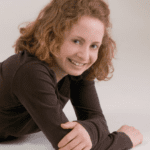
Kathryn Boland is an RCYT and R-DMT (Registered Dance/Movement Therapist). She is originally from Rhode Island, attended The George Washington University (Washington, DC) for an undergraduate degree in Dance (where she first encountered yoga), and Lesley University for an MA in Clinical Mental Health Counseling, Expressive Therapies: Dance/Movement Therapy. She has taught yoga to diverse populations in varied locations. As a dancer, she has always loved to keep moving and flowing in practicing more active Vinyasa-style forms. Her interests have recently evolved to include Yin and therapeutic yoga, and aligning those forms with Laban Movement Analysis to serve the needs of various groups (such as Alzheimer’s Disease patients, children diagnosed with ADHD, PTSD-afflicted veterans – all of which are demographically expanding). She believes in finding the opportunity within every adversity, and doing all that she can to help others live with a bit more breath and flow!


